Who Bought the $6.5 Trillion in Treasuries Piled on the Incredibly Spiking US Debt in 22 Months? Who Holds the $30 Trillion?
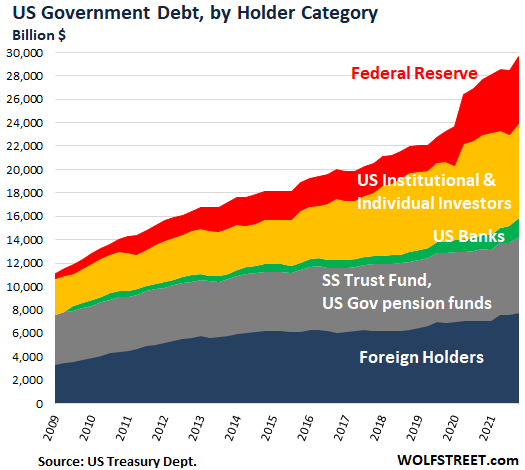
The question is particularly hot because Treasuries are now ugly instruments with the worst punishment yields ever.
By Wolf Richter for WOLF STREET.
In face of the incredibly spiking US gross national debt that just hit $30 trillion after having spiked by a mind-boggling $6.5 trillion since March 2020, the steamy-hot question is this: Who the heck is buying and holding all these Treasury securities?
The question is particularly hot because these are very unattractive instruments: Yields are still well below 1% for most short-term Treasury bills, and even the 10-year Treasury maturity yields only around 2%, while CPI inflation has blasted off and hit 7.5%, creating the worst punishment yields ever. To top it off, the most reckless Fed ever is still repressing interest rates and is still, though at a much slower pace, printing money.
The whole thing is a tragic clown-show, and yet every single one of the Treasury securities was bought and is held by some entity. Who are they? This is my quarterly update on who is holding this debt, and it’s an increasingly important question for increasingly iffy times.
Foreign Creditors of the US government.
Foreign holders of Treasuries: $7.74 trillion, a record, up by $790 billion (+11%) since March 2020, and up 9.5% year-over-year, according to the Treasury Department’s Treasury International Capital (TIC) data.
About $4.1 trillion of it is held by foreign central banks and government entities; the rest by foreign institutional investors, corporate entities, banks, and individuals.
But their holdings have increased more slowly than the incredibly spiking US gross national debt over the years, and in December accounted for 26.1% of the debt, down from the 34% range in 2012 through 2015.
Dollar amount of holdings = blue line, left scale; total foreign holdings as % of total US debt = red line, right scale:
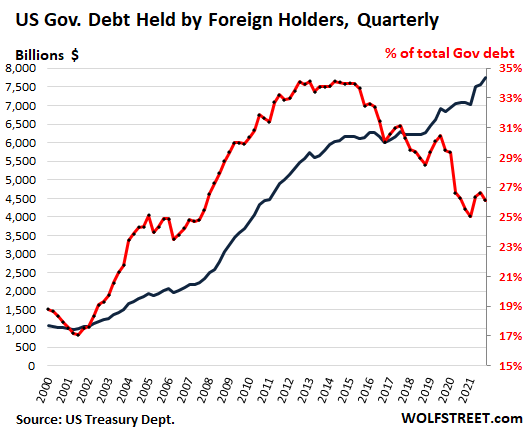
Japan: $1.30 trillion at the end of December. The largest foreign creditor of the US has increased its holdings since March 2020 by $31 billion.
China: $1.07 trillion. The second-largest foreign creditor of the US has cut its holdings since March 2020 by $16 billion:
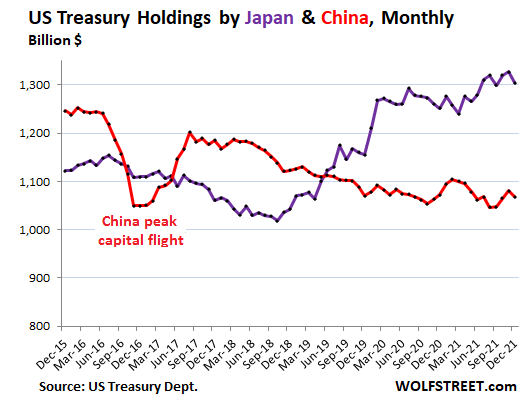
Given the incredibly spiking US gross national debt and the relatively stable holdings over the years of Japan and China, their importance as creditors to the US has been declining for years. In December, Japan’s share (purple) dropped to 4.4% and China’s share (red) dropped to 3.6%. So they’re not the ones that are bailing out the US government:
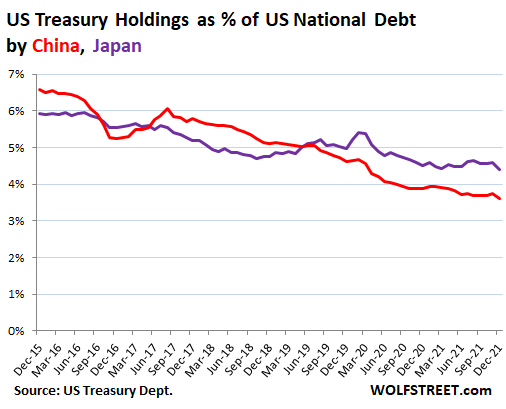
Other big foreign holders don’t measure up to the task. Not so ironically, most of the 10 biggest foreign holders after Japan & China are tax havens and financial centers, some of them small countries that cater to US corporations that want offshore mailbox entities where some of their Treasury holdings are registered.
The UK’s “London Laundromat”: $647 billion, about 2.2% of the total US debt outstanding, and growing rapidly, up 47% from a year ago. The Number 3 foreign holder of US Treasury securities is concentrated on London’s financial center, lovingly called, “London Laundromat,” holds $647 billion in Treasury securities. The ultimate holders of these Treasuries registered at accounts in the London Laundromat could be anything from Russian oligarchs to US corporations.
The top 10 foreign holders behind Japan and China:
- UK (London financial center): $647 billion (+47% year-over-year)
- Ireland: $334 billion (+5% year-over-year)
- Luxembourg: $323 billion (+12%)
- Switzerland: $288 billion (+13%)
- Belgium (home of Euroclear): $272 billion (+7%)
- Cayman Islands: $262 billion (+17%)
- Taiwan: $251 billion (+7%).
- Brazil: $244 billion (-5%)
- Hong Kong: $226 billion (+0.5%)
- France: $224 billion (+101%)
But big trade deficits don’t mean those countries have to hold a lot of Treasury securities: Germany and Mexico, the two countries outside China and Japan with which the US has had gigantic trade deficits for years, hold only $83 billion and $46 billion respectively in Treasury securities.
Domestic creditors of the US government.
US government “internal” holdings: $6.47 trillion, a record, up by $327 billion (+5.3%) year over year, and up by $461 billion (+7.7%) from March 2020, according to Treasury Department data (blue line, left scale).
US government pension funds for military personnel and federal civilian employees, the US Social Security Trust Fund, and other federal government funds invest their massive balances exclusively in Treasury securities. This “debt held internally” is often and ridiculously described as debt that the government “owes itself”; but that’s malarkey. It’s owed to current and future beneficiaries of those funds.
But even this increase couldn’t keep up with the incredibly spiking US national debt, and the share of the US Treasuries held by these funds, at 21.9%, remained near the multi-decade low of the prior quarter, and was down from a share of 45% in 2008 (red line, right scale):
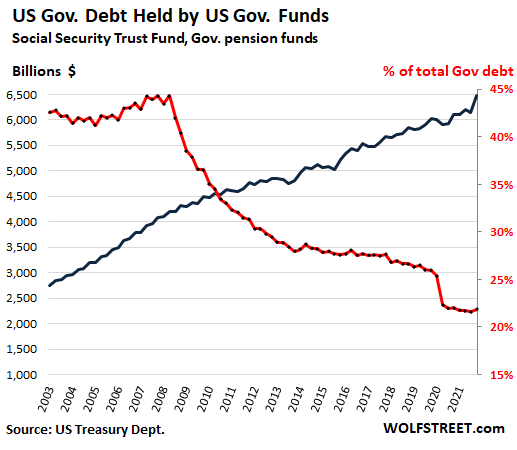
Federal Reserve: $5.65 trillion at the end of December, up by nearly $1 trillion (+20%) year-over-year, and up by a gargantuan $2.31 trillion (+69%) from March 2020, the result of the most reckless money-printing binge ever (blue line, left scale).
The Fed’s holdings of Treasury securities reached a record 19.1% of the incredibly spiking US national debt in Q3 and held at that record in Q4 (red line, right scale):
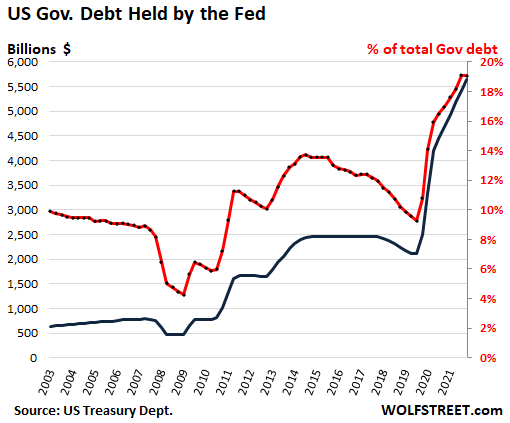
US Banks: $1.66 Trillion, according to the Federal Reserve Board of Governors’ data on bank balance sheets. This was up by $450 billion (+37%) year-over-year and by $690 billion (+71%) from March 2020, as banks, loaded up with cash, are gorging on Treasury securities. They now hold 5.6% of the incredibly spiking US national debt:
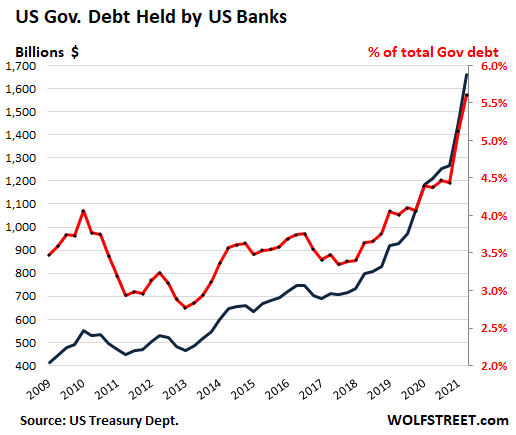
Other US institutional and individual investors: $8.09 Trillion, down by $522 billion (-6.1%) year-over-year but up a whopping $1.68 trillion (+26%) from March 2020.
These include bond mutual funds and money market funds, US pension funds, individual investors, US insurance companies, state and local governments, and other US entities. The sharp volatility of these holdings indicates that some groups dumped Treasuries in March 2020, and then, when the Fed made clear that it’s going hog-wild, they jumped back into the Treasury market and bought everything in sight. Their holdings hit a peak in Q1 2021. Since then, they backed off.
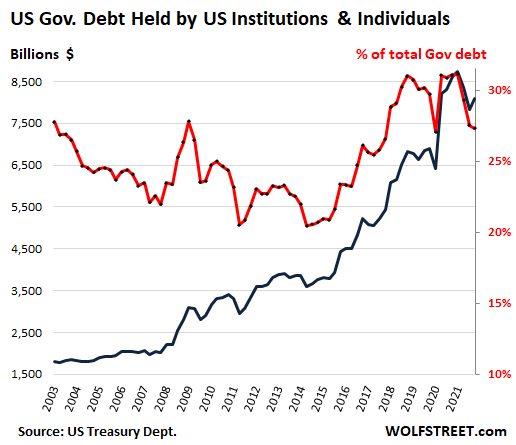
In summary: the major holders the incredibly spiking US National Debt:
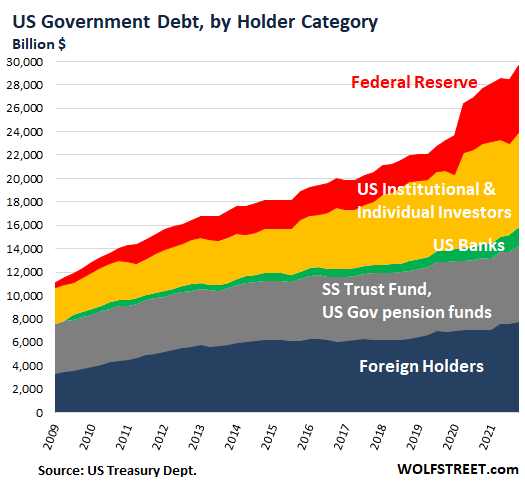
And the incredibly spiking US national debt itself:
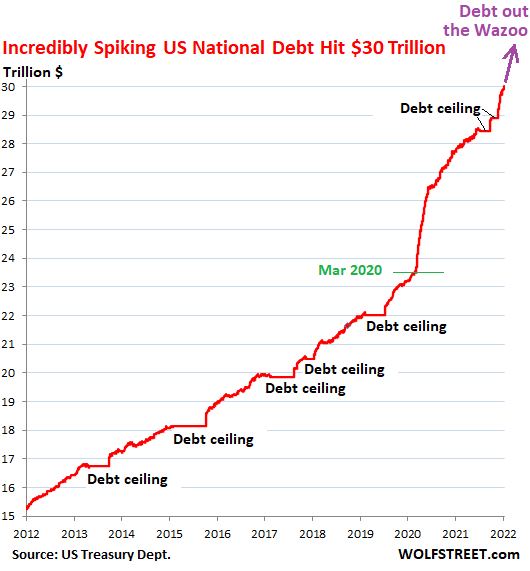
Enjoy reading WOLF STREET and want to support it? Using ad blockers – I totally get why – but want to support the site? You can donate. I appreciate it immensely. Click on the beer and iced-tea mug to find out how:
Would you like to be notified via email when WOLF STREET publishes a new article? Sign up here.
![]()
Source link






